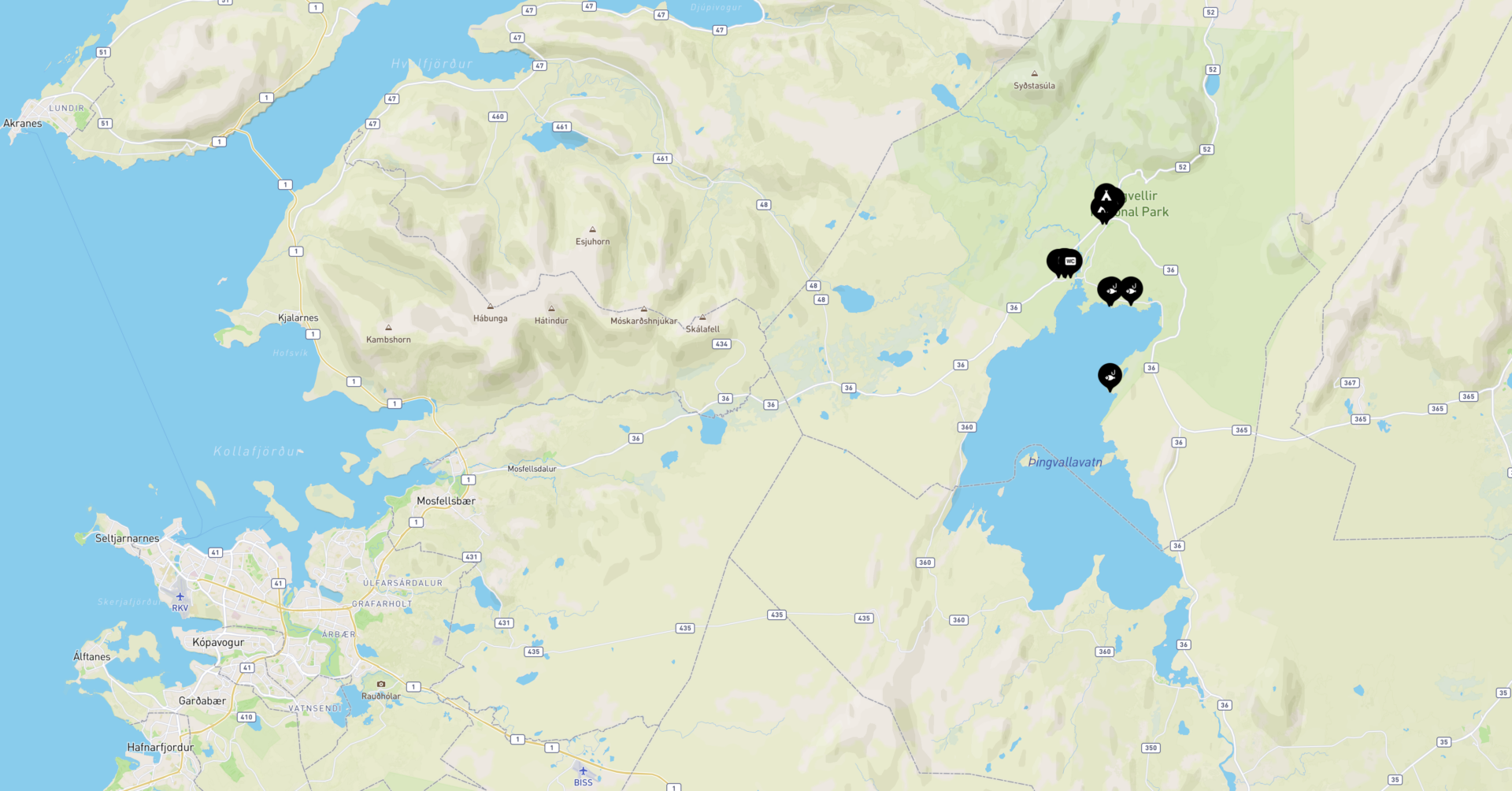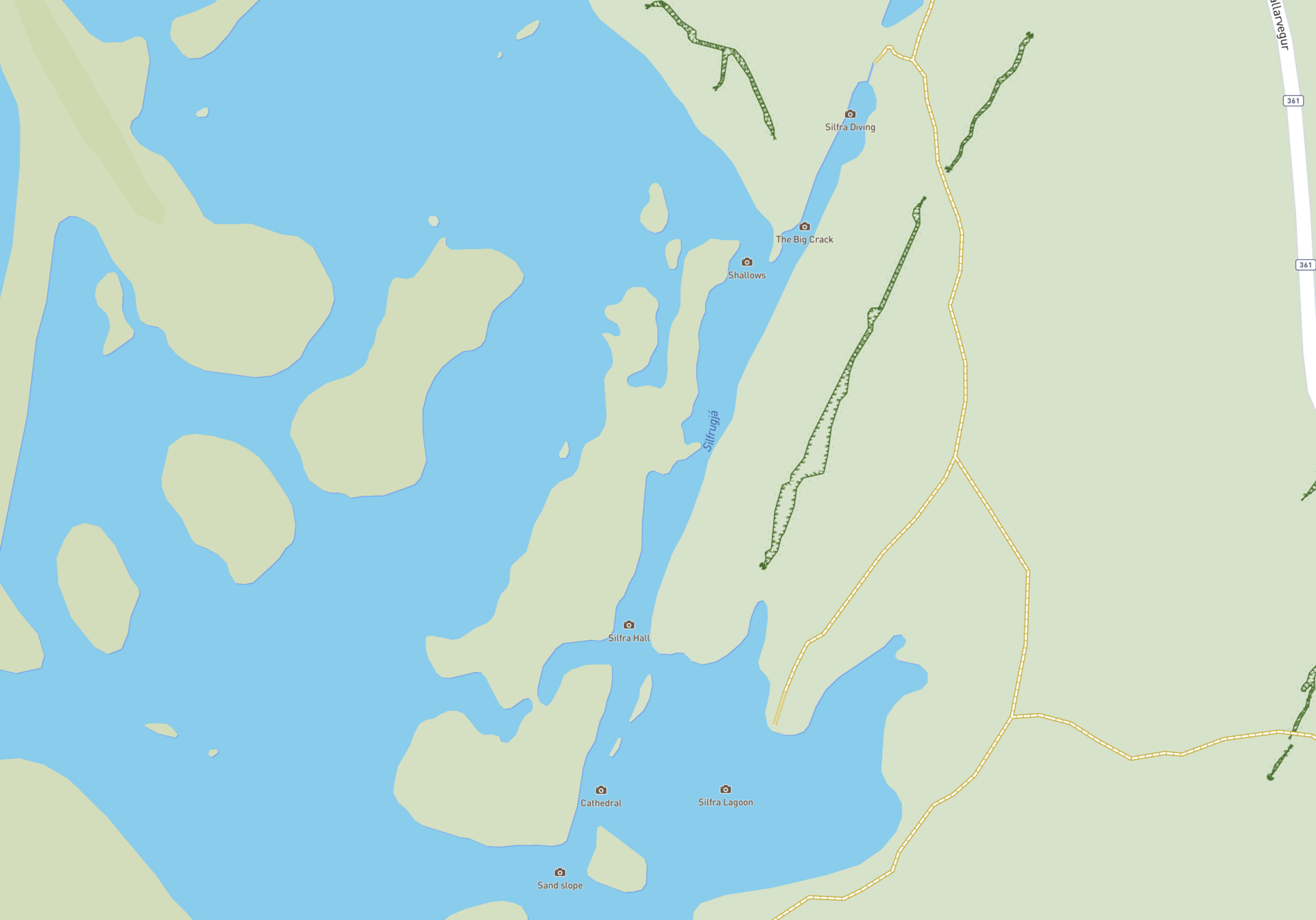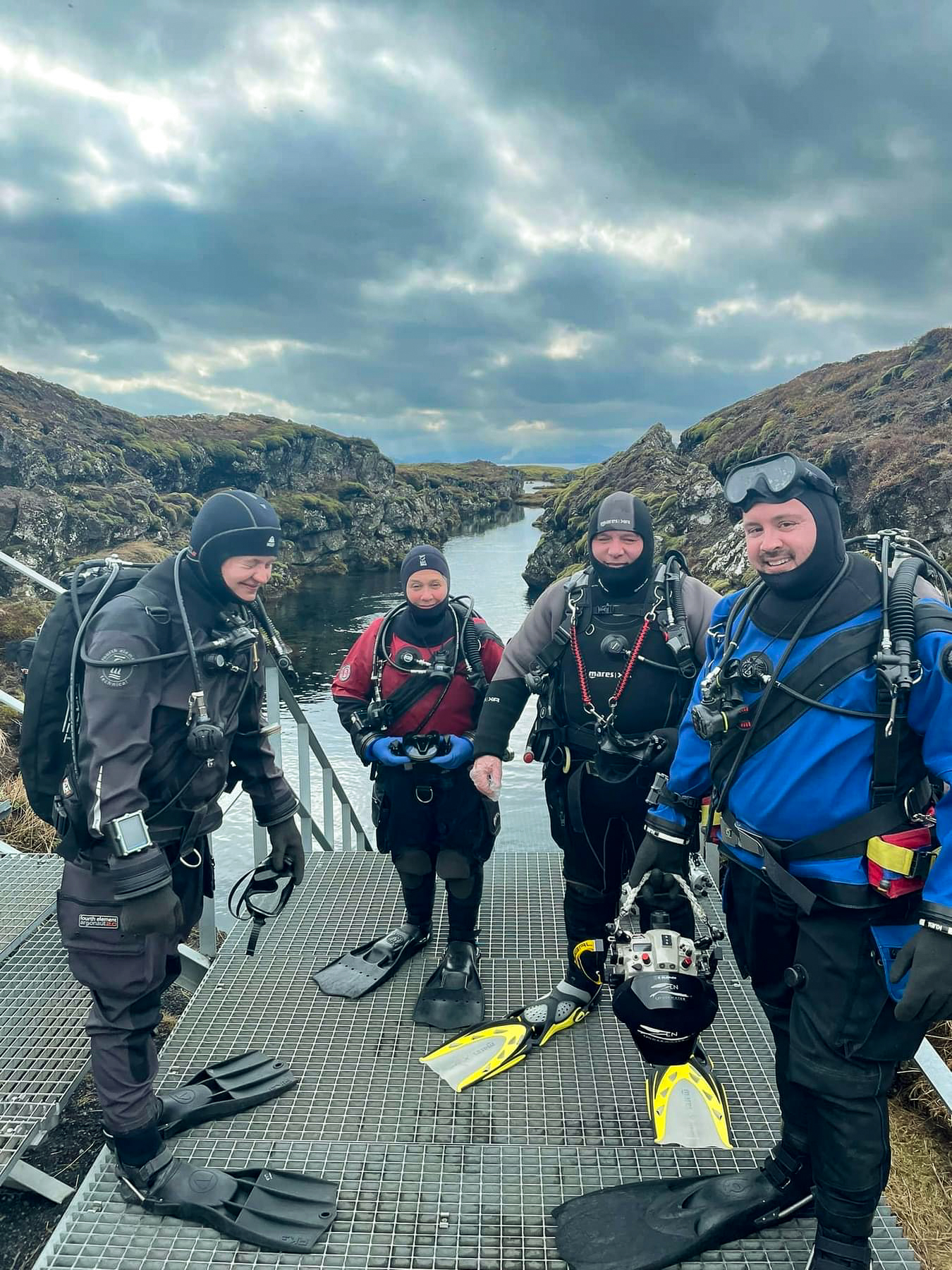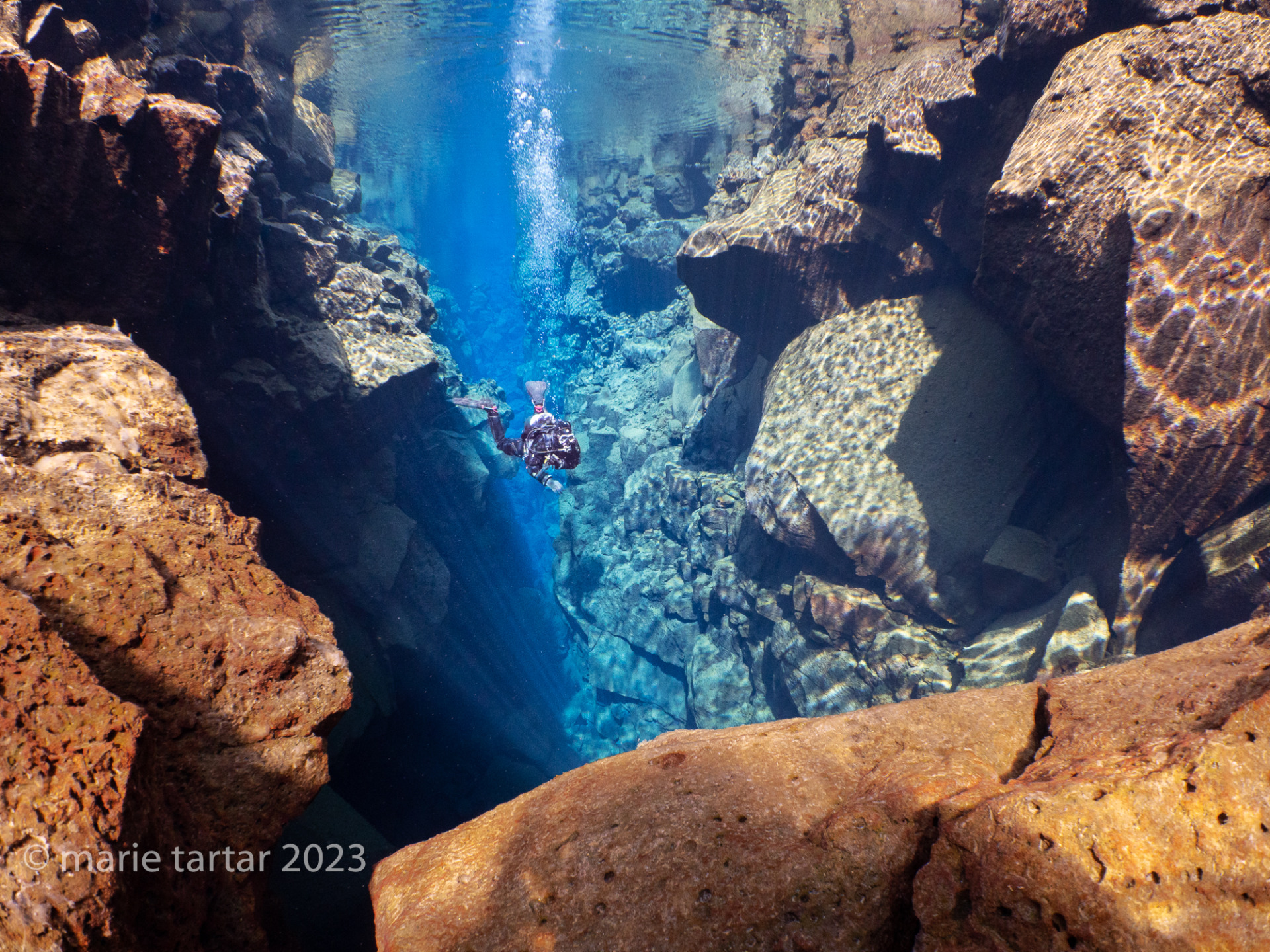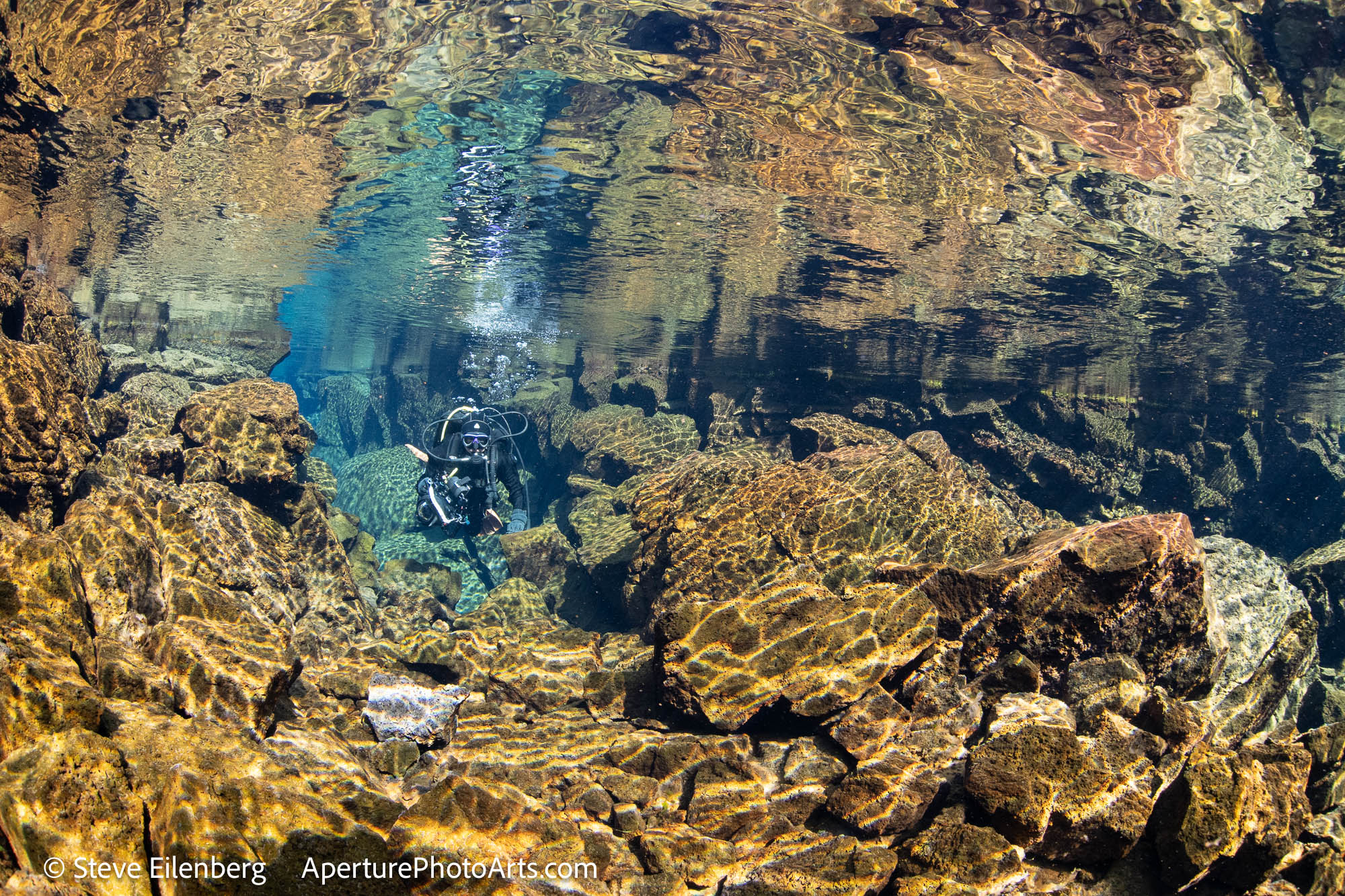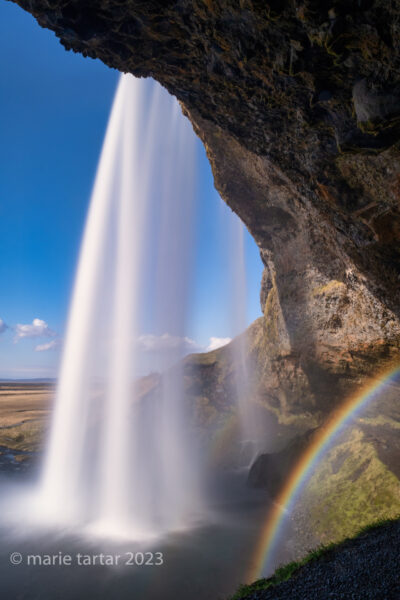
After an amazing week exploring Iceland’s south coast and re-visiting the Snaefellsnes Peninsula, topped off by a walking food tour in Reykjavik, it was on to the main course, the organizing principle, the impetus for us to return to Iceland, this time in April: Silfra. Silfra means silvery in Icelandic. It is one of several fissures which resulted from an earthquake in the Thingvellir region in 1789, but unique in that it filled with glacial meltwater, thus lending it its name (one of the very few, easy to pronounce Icelandic names I’ve encountered!). The meltwater derives from Langjökull (long glacier in Icelandic) to the north and is filtered over 30-100 years through porous lava rock before emerging as exceptionally clear potable water in Silfra and Þingvallavatn Lake.
Steve had been dubious about diving in such extremely cold water, a predictable 2-4 degrees C (36-39 degrees F or Frreeeezzzzing now matter what system you use!). Greg was game, even enthusiastic. I was intrigued, albeit intimidated, but motivated to do more drysuit diving now that we were back into cold water diving. We had been to Iceland twice before, both times in July, but had passed both trips on diving Silfra, a world famous dive site. It felt like we had unfinished Icelandic business.

Adventures in cold water, with Steve (below and to left) and Greg (above to the right) in the continental crack that is Silfra in Iceland. The North American tectonic plate is to the left and the Eurasian is to the right.
Silfra is a terrestrial manifestation of the Mid-Atlantic Ridge (the world’s longest mountain range, albeit underwater) which passes through Iceland. This is where the North American and Eurasian tectonic continental plates meet. The two continents are slowly diverging, at a rate of 2 cm/year. This also happens to be a UNESCO world heritage site, Þingvellir (Thingvellir) National Park, where Iceland’s parliamentary assembly, the Althingi, began meeting in the year 930, continuing until 1798.
Monday, April 17, 2023
Today was the first official day of the workshop, a non-diving day dedicated to organizing to dive and photograph Silfra. Byron picked us up at 11 am for the quick run over to Arctic Adventures’ capacious and well organized dive center, where we met our dive guide for the week, Mattia from Italy. Steve, Greg and I formed one dive group, with Mattia, while Guillaume from France and Eliska from Croatia were the other dive guides for our small groups of 2-3 divers.
Most of the group were already installed at the comfortable and well located Hotel Skuggi in central Reykjavik. We ran into trip leader Alex Mustard on the street the prior day, heading back to the hotel with his young daughter in tow, heading off a potential “bathroom emergency”.
We had met Kathryn from Seattle the prior day on the nourishing and filling Wake Up Food Tour . She had also been exploring terrestrial Iceland the prior week. Being solo, Byron had hooked her up with Arctic Adventures’ small group South Coast and Snaefellsnes Peninsula tours.
Mehmet from Turkey had also been exploring topside Iceland with his wife, who was now back in Europe.
The rest of our party flew in that morning. I was amazed Janeiro from Atlanta and Philip from San Francisco were even awake for Alex’s presentation, covering techniques for photographing Silfra. We had met Brian (an American working with supercomputers in London) during our September trip to British Columbia. On this trip, his non-diving wife Jillian accompanied him.
Byron had stored our dive gear and underwater photography equipment at the dive center for the week we were traveling together. With Mattia’s aid, we assembled our mix of personal and rental gear (backplate BCDs and fins). My newly serviced and environmentally sealed regulator was free-flowing and had to be swapped out for a rental. Happily, since we were diving in fresh water (more buoyant than salt) and had weight in a steel tank and the steel backplate, I didn’t have to wear a weight belt or harness, just one 4 kilo weight in each BCD pocket.
Alex gave a preview and techniques talk in the classroom at the Dive Center.
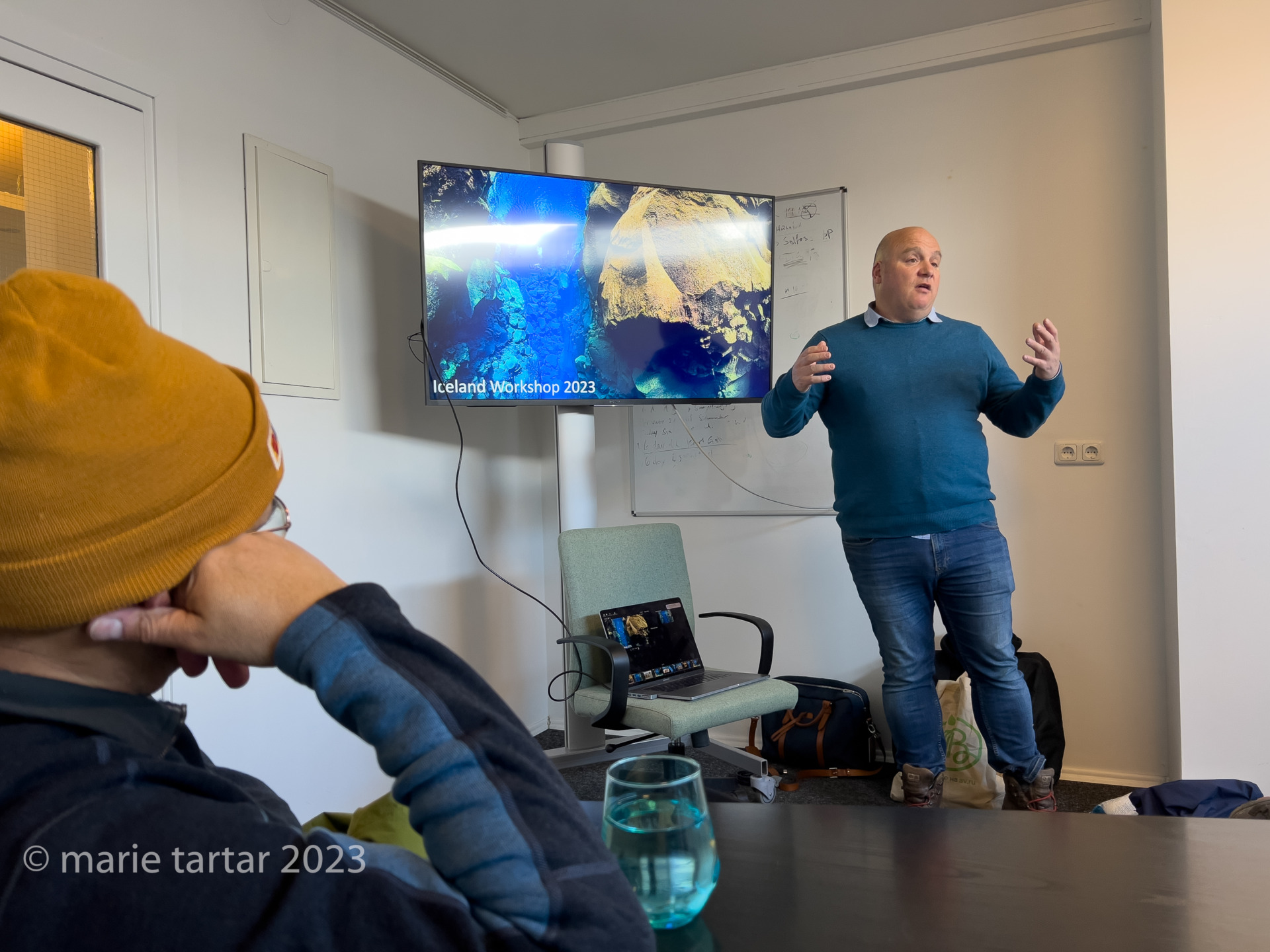
Alex gave a preview and techniques lecture which was really helpful for maximizing our photography under brain freeze conditions.
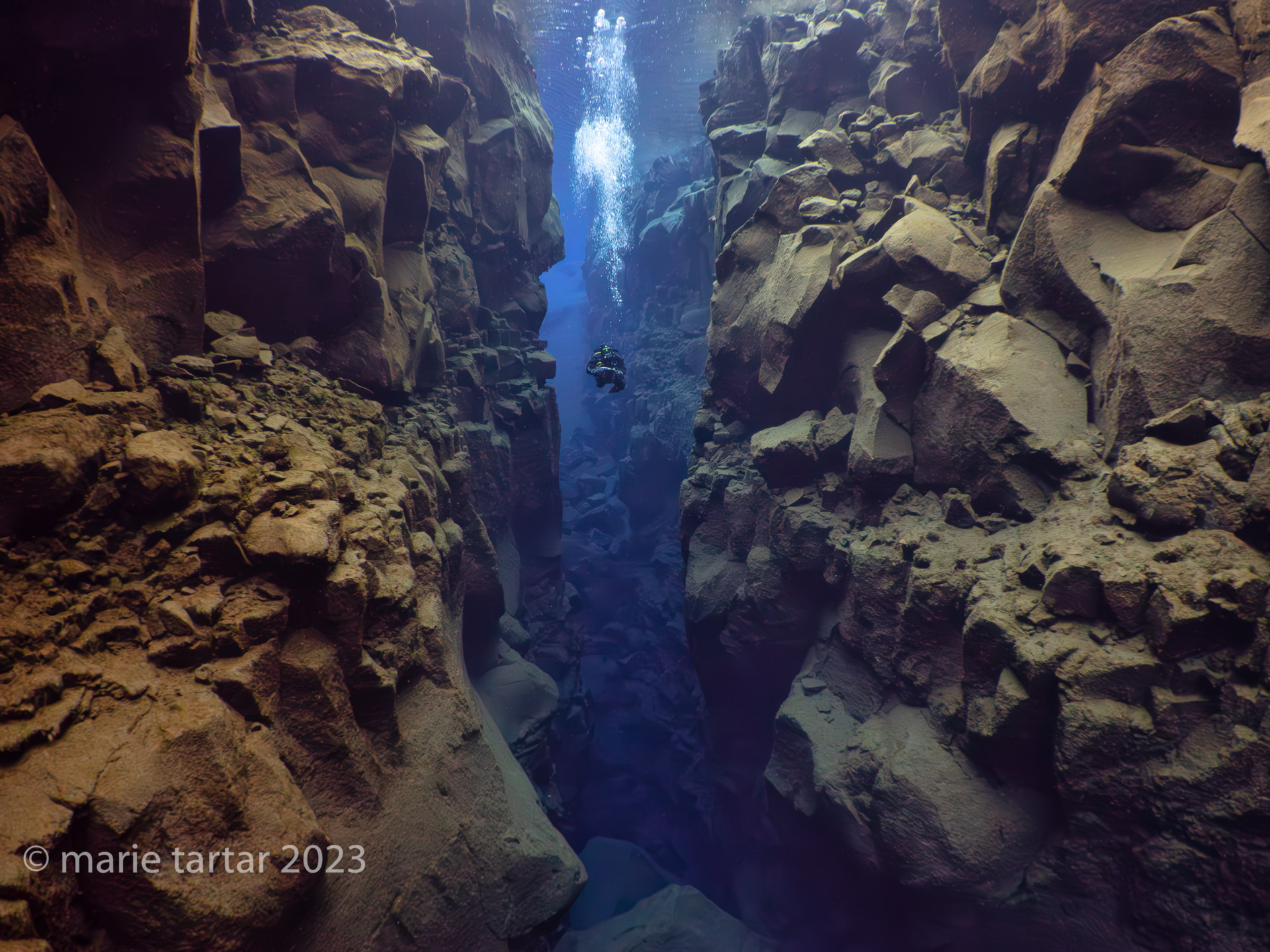
Silfra: Big canyon, little diver (Steve) and cold, clear, blue glacial water. Alex’ talks were full of helpful tips. Normally I don’t really like diver’s bubbles in my shots, but I had to agree having a diver in the shots really helped emphasize the scale of the tectonic formations and the bubbles help to draw the eye to the diver. He also was right on about excluding the bright sky (even on overcast days).
Back in Reykjavik, Steve, Greg and I made a beeline to the first restaurant from the prior day’s food tour for a 3 pm late lunch. My lamb soup was so filling, I was still stuffed when the group assembled later for dinner and foraged for food at the nearby Hlemmur Mathöll foodhall, inside the former main bus terminal of Reykjavik. Eventually, Steve and I split a bahn mi sandwich (good flavor, pork was too fatty), after Greg and I sampled (between us) 4 different excellent Gaeta gelatos, including mango sorbet, amarena cherry, lemon pistacio and licorice (I have never liked licorice, but this was surprisingly appealing).
Tuesday, April 18, 2023
It was dreary and raining today, which was just as well, as this day effectively was our dress rehearsal day to work out drysuit and photographic kinks, with better weather expected in the following days.
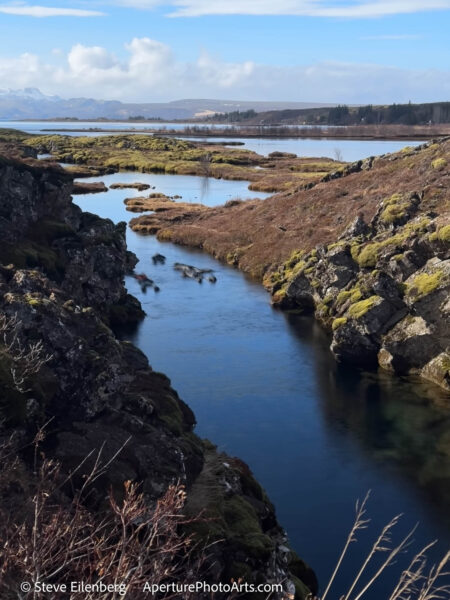
Silfra, with snorkelers in the continental crack, with Europe the rock to the left and North America to the right.
Mattias enlisted Guillaume in the struggle to liberate my newly acquired Kubi drysuit glove, attached via a new ring system, from my drysuit. Eventually, after a mighty effort and additional lubrication, it yielded, becoming more cooperative with additional use.

One of the more dangerous aspects of diving Silfra, watching out for cars crossing the road! This sign must date back to the heyday of Force Fins, which we once had (ugly in photographs but comfortable to wear).
The approach to Silfra is easy, a short walk across the street from the parking and staging area to a series of metal stairs and a level entry platform.

And they’re off: Testing the dry glove’s water tightness and last minute check of camera settings on the entry platform at Silfra.
The water is a constant 2 degrees C or just above freezing, with a mild constant current. How to describe the shock of the cold, coLD, COLD water temperature-I can only say, it was literally breath-taking! This was despite upgraded Fourth Element drysuit undergarments called Arctic, dry gloves, HotHands warmers and insoles and 10 mm neoprene hoods.
The face quickly goes numb, which is quite bearable. What quickly becomes agony is the progressive, almost excruciating, pain of the fingertips. My right hand fingers, holding the camera, quickly were nearly unbearable. I played an imaginary piano trying to keep the circulation going. My left hand fared a little better- while suiting up, I forgot to put in a hand warmer on the right. Still, it was exhilarating. As the slow constant current swept me down the crack, all of the anxiety of preparation for this trip swept away as I thought: “We’re doing this!”
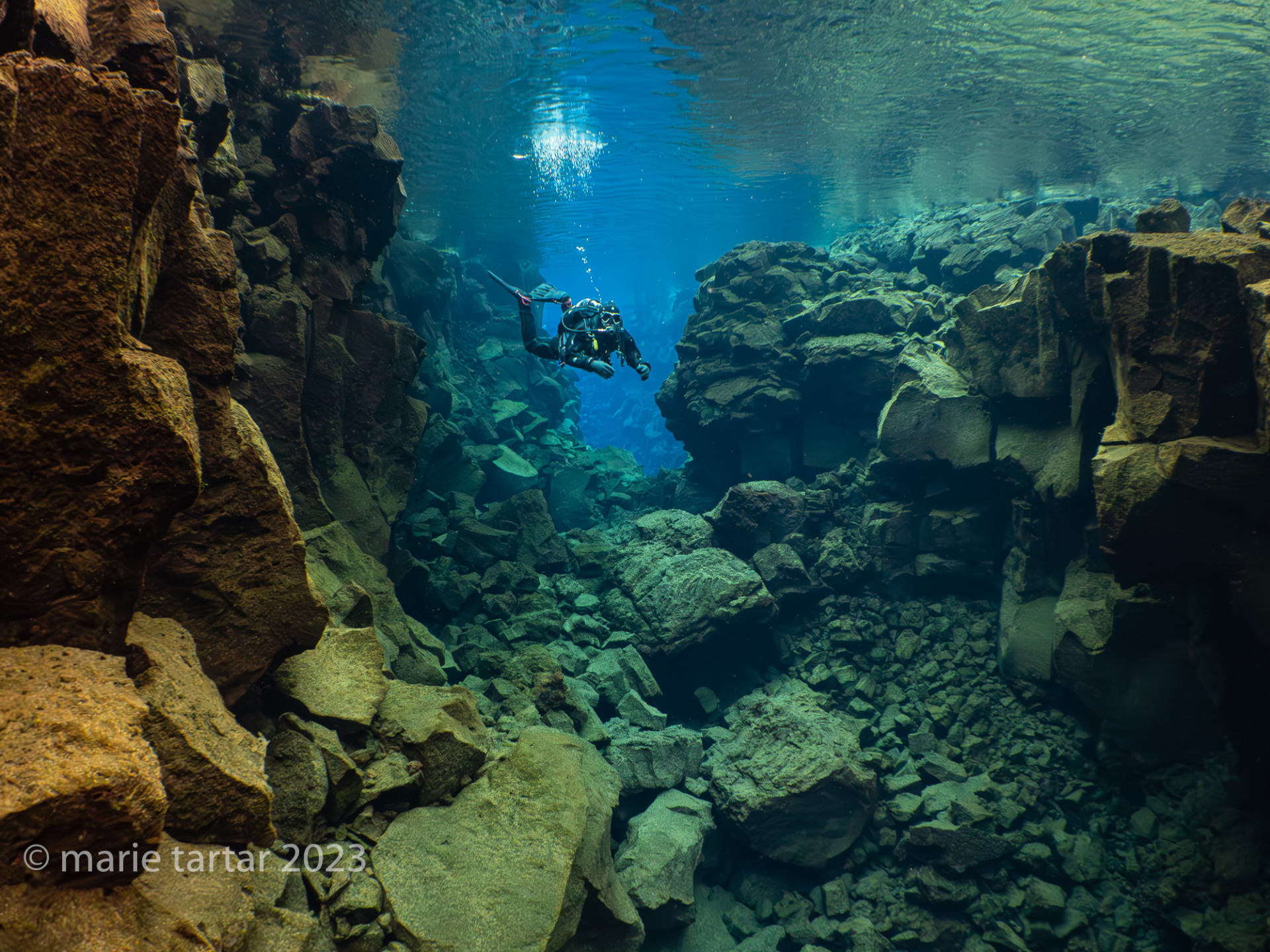
Silfra Day 1: Our Arctic Adventures dive guide, Mattia, also was an obliging model. The overcast skies of our first two days of diving at Silfra made for some nice surface reflections.
In some ways, Silfra is an easy dive. In other ways, it is surprisingly challenging, at least to photograph well. The easy parts? No wave action or surface chop, incredible water clarity, no navigation necessary-this is a slow, one way cruise to a very defined exit point. The hard parts? The cold, the mind-numbing, get-me-out-of this-water-I-can’t-take-another-minute COLD! The buoyancy was surprisingly challenging. Because of the dark skies, we had the most light in the top 20 feet of water, so there was little incentive to dive any deeper. The profile is strange, with several extremely shallow sections, coming to within a few feet of the surface. Drysuit buoyancy is trickiest in the shallows and we all found it a bit of a struggle at first. Steve and I weren’t used to the rental BCDs. On some dives, my fingers were so cold, I could barely operate the valves. Greg had such a wide angle lens that we were constantly making our way into his viewfinder.
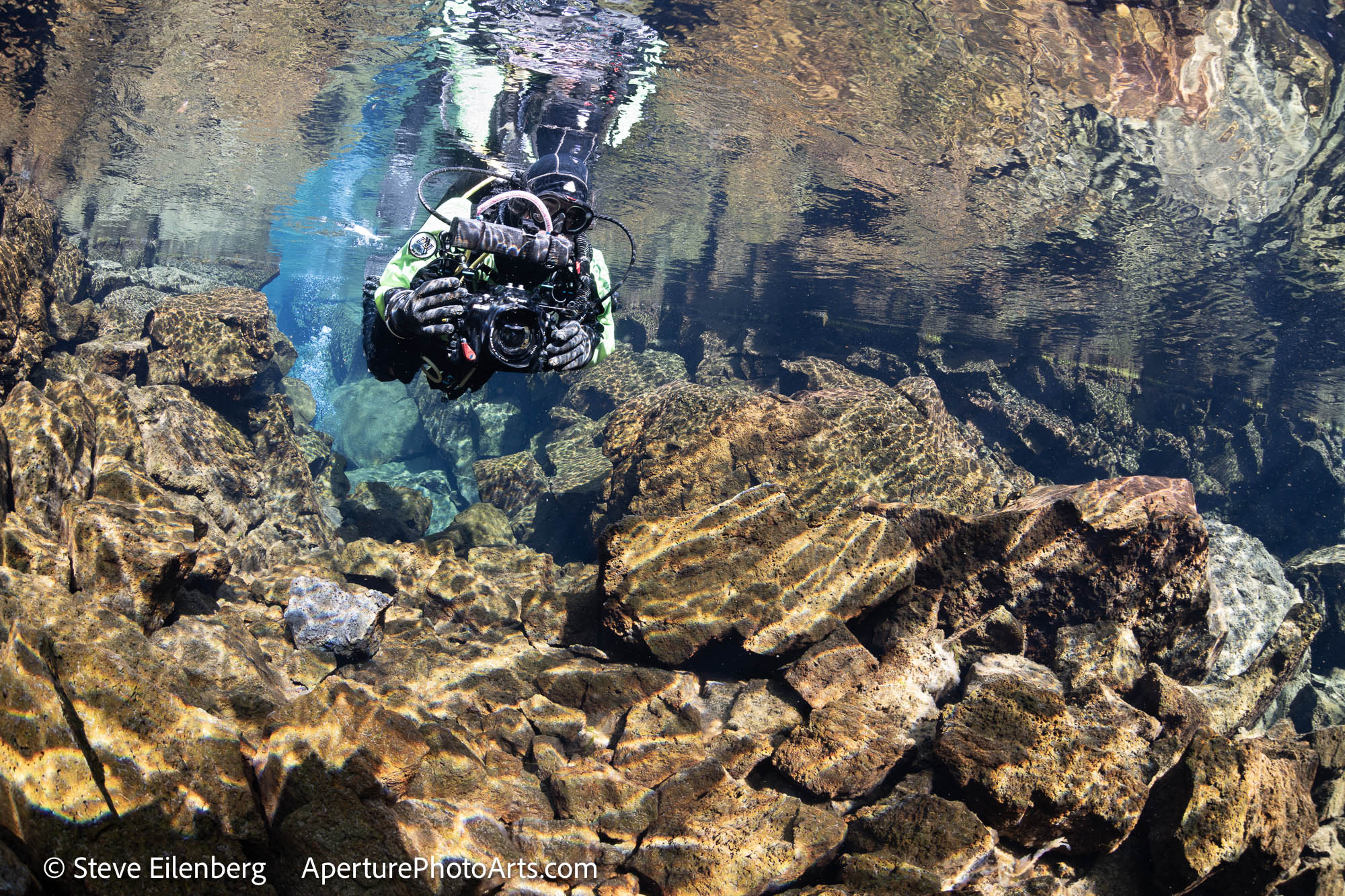
It wasn’t always us sneaking into the viewfinder! Greg in the shallows on our 3rd, last and only sunny day at Silfra, Iceland.
Even the slightest of steadying touches on one of the rocks produced a downstream shower of algae. With all of these factors, it turned out to be very useful to have multiple chances to photograph Silfra, as we did twice each afternoon for three consecutive days. Jillian, who doesn’t dive, braved the cold waters to do one snorkel this first day. Her curiosity was satisfied with that one excursion, but it may just be that she is more sensible than the rest of us.
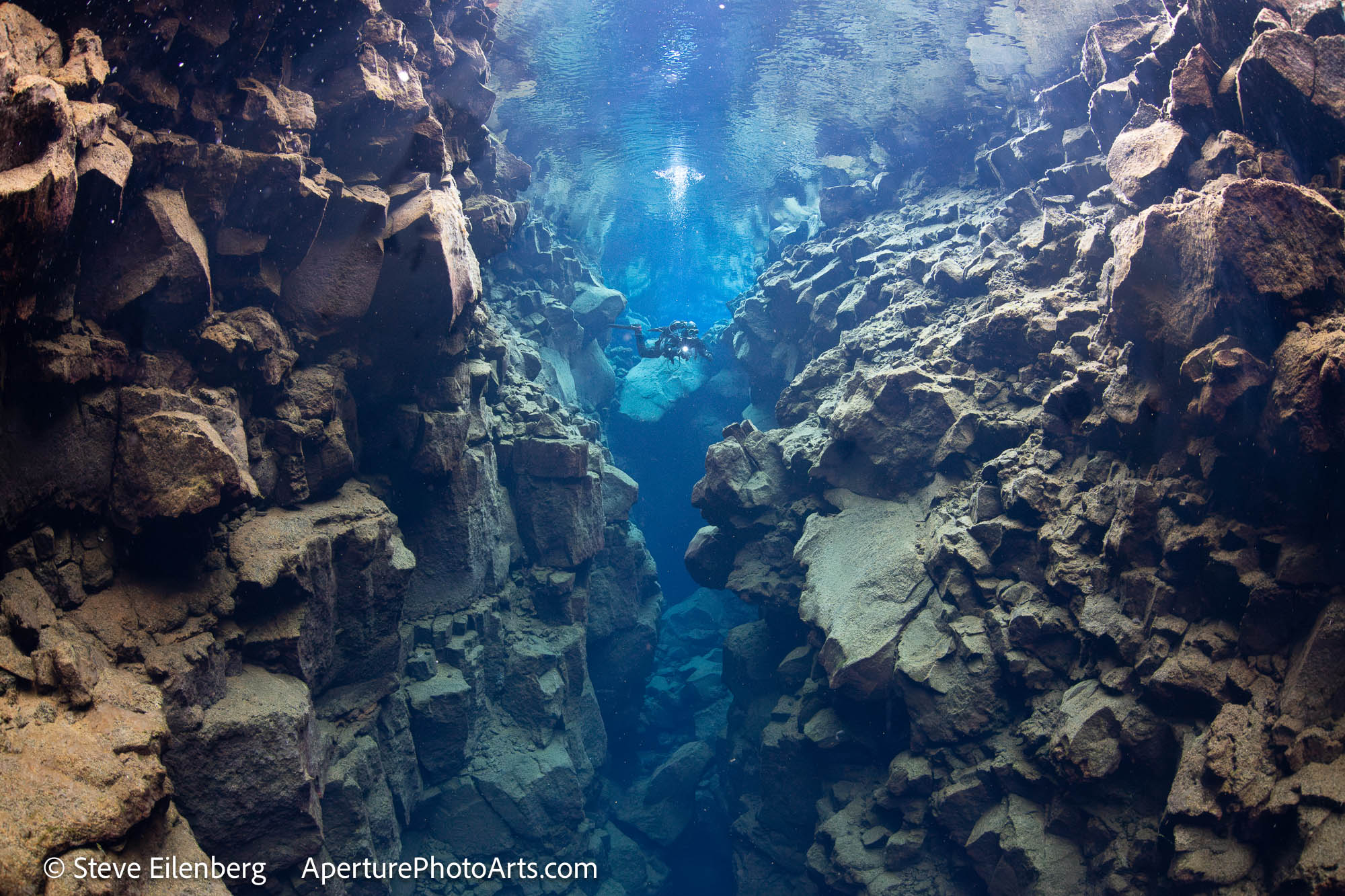
Day 3, Silfra: Two continents diverging, at a rate of 2 cm/year, with volcanic rumblings and rearrangements along the way. Our dive guide and model, Mattia, had a torch on one of our dives.
According to Mattia, we lasted an astounding 53 minutes on our first circuit (although my computer recorded our dive as 45 minutes, with a maximum depth of 33 feet) .
Our surface interval was spent mostly huddled in the warming truck, a large vehicle in which our drysuits had been transported hanging from the Dive Center to Silfra. Byron produced a hearty but unlikely sounding Icelandic snack, harðfiskur, dried fish slices (fish jerky made from wind-dried cod or haddock), which liberally dipped in butter, tasted much better than it sounds.
Entries into the water were staggered by group, so we sometimes found ourselves fully suited up, waiting for the previous group to clear out. There were treacherous benches on which to wait. I say treacherous, because shortly seeing afterJaneiro carried over backward by the weight of his steel tank as he sat down to wait, I fell sideways off the end of another bench, flailing on the ground trying to rise again, as ungainly as a turtle on its back. The vast majority of the groups queued up to enter the water are snorkeling-per Byron, 99.9% of those who brave the frigid waters of Silfra snorkel, rather than dive. I saw one clear advantage of snorkeling-most of the snorkelers kept their gloved hands behind their backs and out of the frigid water.
There have been a handful of deaths at Silfra, leading to the requirements to dive there being formalized and tightened up in recent years. The last death was in 2017, a 60-something male snorkeler, who had a heart attack. Byron was instrumental in revision of the requirements and was involved in the recovery of the body of a young Chinese woman without drysuit experience who perished in Silfra in 2016. Since the requirements for diving were changed to the current standard (proof of dry suit certification or 10 logged drysuit dives, including at least one within the past 2 years), the number of people diving Silfra has decreased by 2/3rds. I can hardly believe people were allowed to dive it previously with NO prior drysuit experience. Even with a fair amount of experience drysuit diving, we found it challenging (admittedly, it was the combination of doing photography with diving that was challenging; diving by itself would have been quite a bit easier, I think).
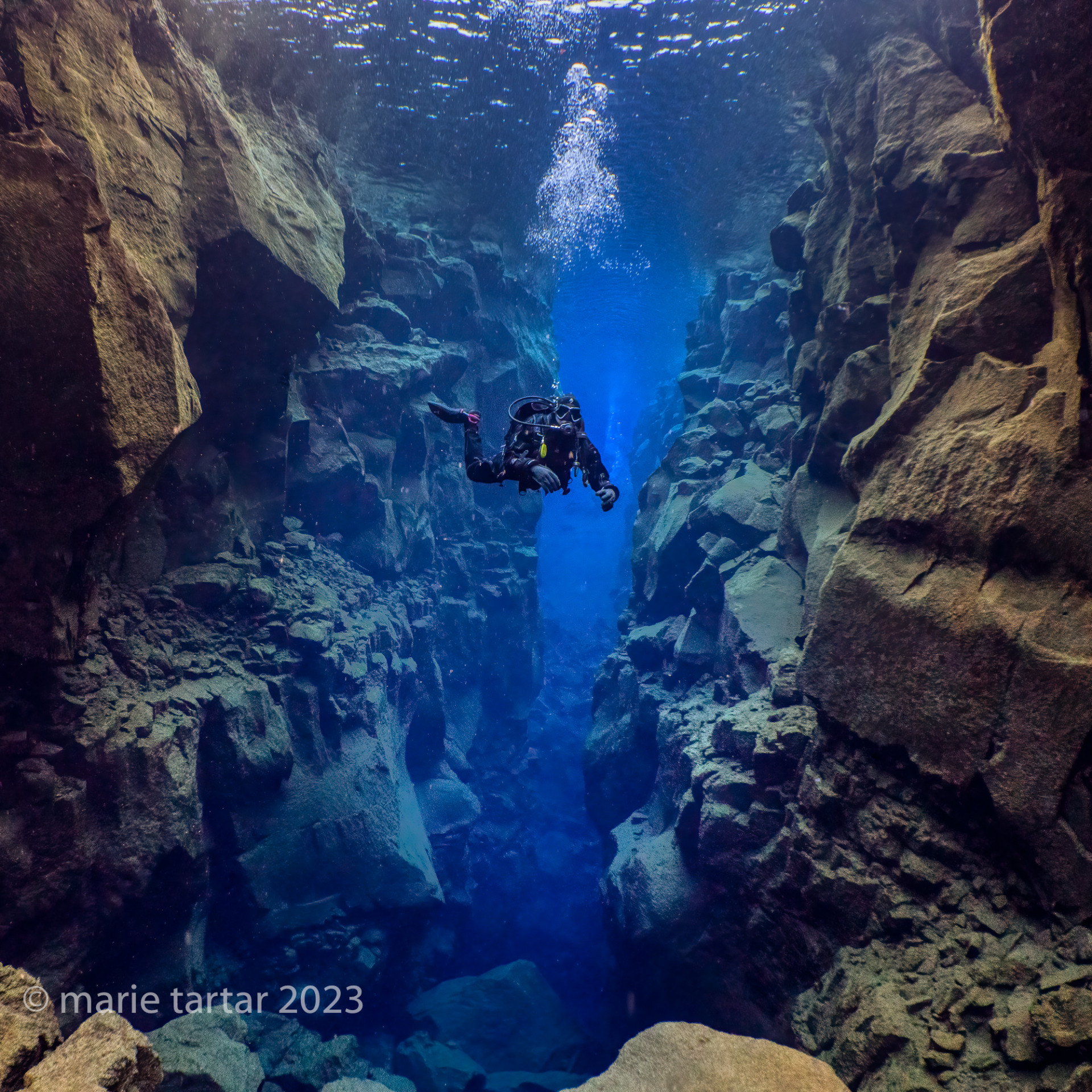
Silfra, Day 1: Arctic Adventures dive guide and model, Mattia, in the continental crack of Iceland. Alex had warned us not to include the sky, which would blow out compared to the dark canyon, which proved to be good advice.
The cold crept up on my hands much more quickly on our second dive, with both hands shrieking by the end of a mere 23 minutes, to a maximum depth of 27 feet. Steve was frozen from head to toe and couldn’t wait to exit the water. Greg fared better, having borrowed a thick liner glove from Byron after the first dive.
Back in Reykjavik, most of the group headed to the nearby food hall for dinner. Steve, Greg and I elected to walk toward town to a favorite from our prior trips, an outstanding Indian restaurant, Astur-Indiafelagid. We gorged and over ordered, having had only harðfiskur as sustenance since breakfast. The standouts were the knockout nights cocktail of gin, coconut, mango and chile, cafreal scallops (pan-fried scallops marinated in ginger, garlic, coriander and curry leaves), lasooni lobster (langoustines spiced with ginger, garlic, garam masala and green chile) and meen kulambu (salmon simmered in cumin, mustard and fenugreek seeds).
Wednesday, April 19, 2023
Steve woke up sore, but surprisingly, I felt minimal residual, just a sensation of having exerted myself. I attributed this relative lack of soreness, despite the walk fully geared up, to the weight distribution from the metal backplate BCD we were renting (our first time diving in non-jacket style BCDs).
We again started our day at the Dive Center, with Alex recapping techniques for shooting Silfra and reviewing some of the submitted images taken by the group the prior day. Most helpfully, he also processed some of them on the fly.

Day 3, Silfra: For our first dive, Mattia the model was now equipped with a strong torch light as an additional point of interest to draw the eye to the diver. Steve did a better job of capitalizing on this than I did. I was barely functioning during this dive, with a hand frozen to uselessness due to a dry glove leak.
In the afternoon, we again did two dives. The conditions were largely the same as the prior day, cloudy and dark. My hands were excruciatingly cold within 5 minutes of entering the water. It seemed to happen faster with each dive. We managed only 23 minutes to a depth of 27 feet.

Day 1, Silfra, near the end of the section of Silfra called the Cathedral and just before the left turn to exit through the lagoon.
Byron, Brian and Eliska came to my rescue during the surface interval. Eliska had a second pair of Fourth Element gloves, much more padded and thicker than any of mine, while Brian had a back up set of men’s kitchen gloves large enough to accept the padded gloves. I was no longer concerned with manual dexterity-the cold was so intense it didn’t matter how well the gloves fit. Never mind the extra phalanx length of these borrowed gloves, I actually was much better able to concentrate on photography thus attired during the second dive, at least for the first half of the dive, managing 50 minutes, to a depth of 23 feet.
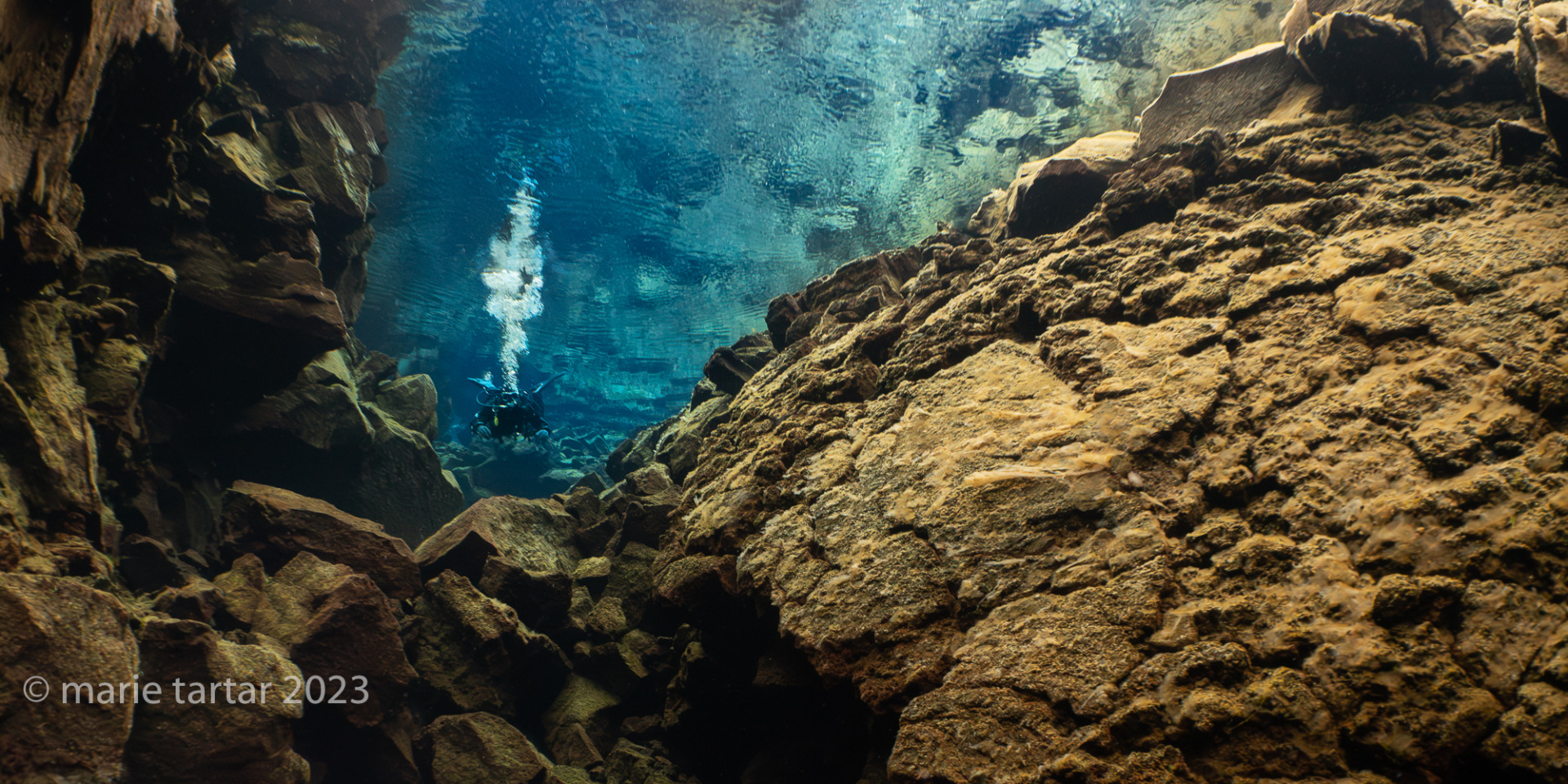
Day 1 : Silfra, with dive guide-model, Mattia, perhaps my favorite of my images from this memorable site.
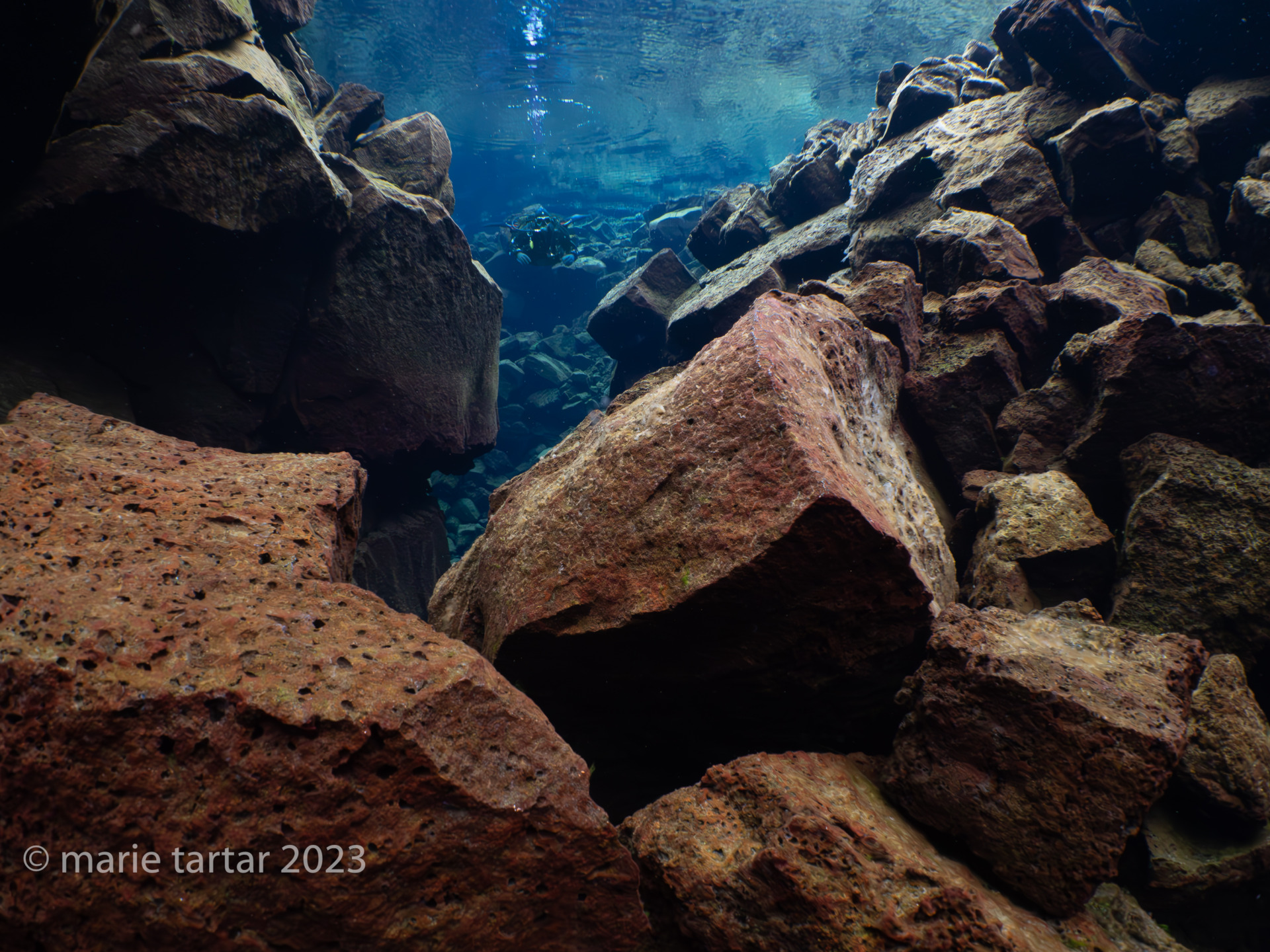
Day 2, Silfra, Iceland: Not a marine life destination, but remarkable for its water clarity, geologic formations and history. I did see one tiny fish, about the size of my pinkie finger.

Day 2, Silfra, Iceland: Big boulders, clear water, small diver (Mattia). The landscape is rearranged periodically by volcanic activity.

Day 2, Silfra, Icelamd: Even though I thoroughly enjoyed (overall) this cold water adventure diving Silfra, I was thrilled each time I saw these jagged rocks, which marked the end of the Cathedral and the turn off into the lagoon and at the other end of the lagoon, the exit and eventual warmth!
Steve , Greg and I returned again to Astur-Indiafelagid for dinner. This time, we managed to tame our frenzy and ordered a more reasonable amount of food.
Thursday, April 20, 2023
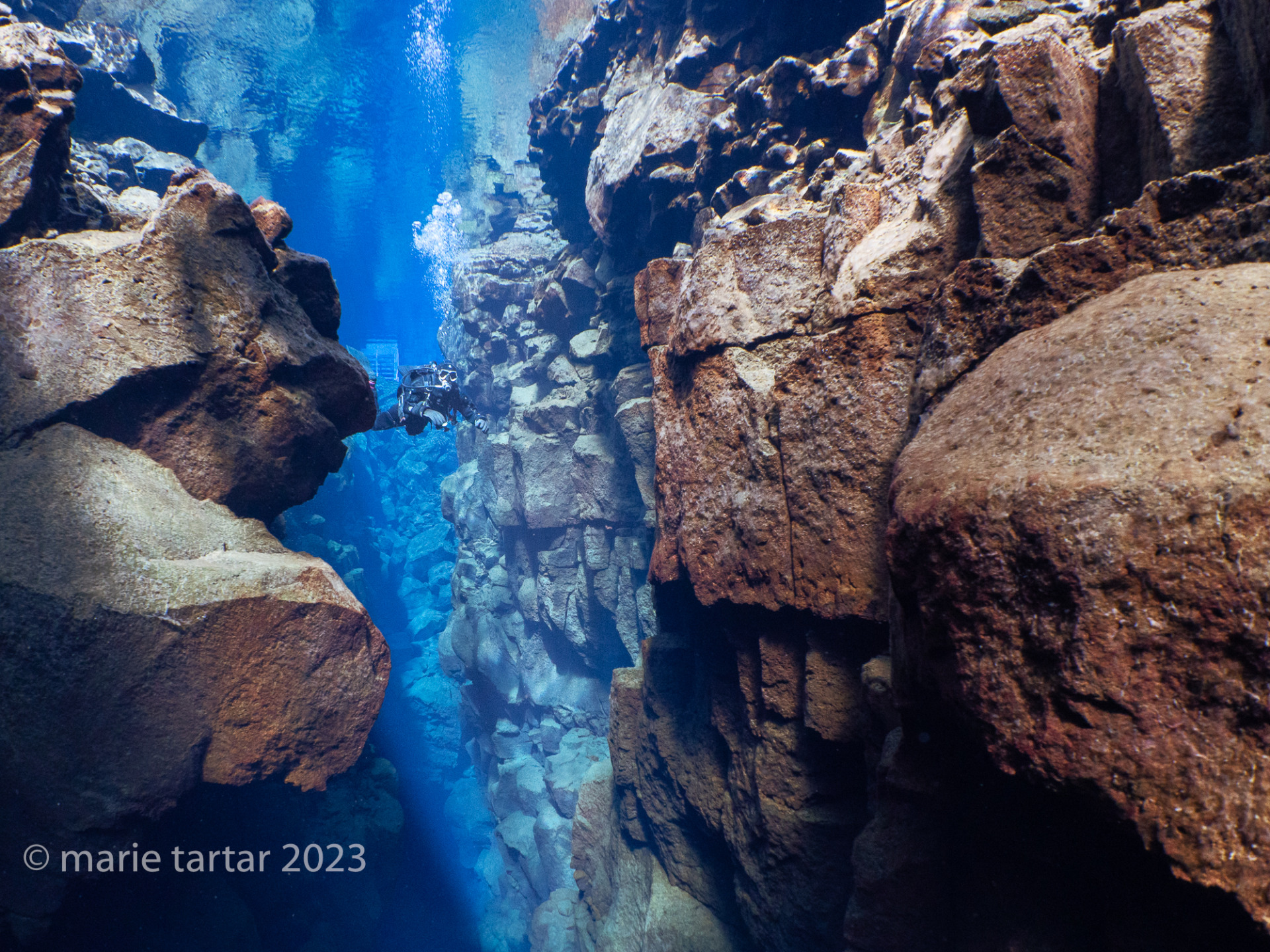
Day 3, Silfra, when the sun finally came out (it was the first official day of summer in Iceland), looking back to the entrance platform (behind Mattia) in the so called Big Crack. North American tectonic plate is to left and European plate is to right.
Our third and final diving day at Silfra was not without issues . Even with better padded and thicker gloves, my finger tingling quickly became near unbearable, so bad I had trouble controlling my position in the water, being almost unable to operate the buttons on my rented BCD to introduce air or vent it as needed. A large part of the problem was I had a dry glove leak. I could feel wetness inside my left glove, then dampness up my left sleeve. Despite this, we eked out 46 minutes, to a depth of 22 feet.
During the surface interval, I learned from Byron that I should have immediately addressed the dry glove leak by surfacing and doffing and replacing the outer glove, which probably was leaking due to a small spot of grit on an O-ring, as it did not leak on the second dive. I spent the entire surface interval huddled in the warming van, with the damp glove wrung out and on the floor in front of the heat vent.
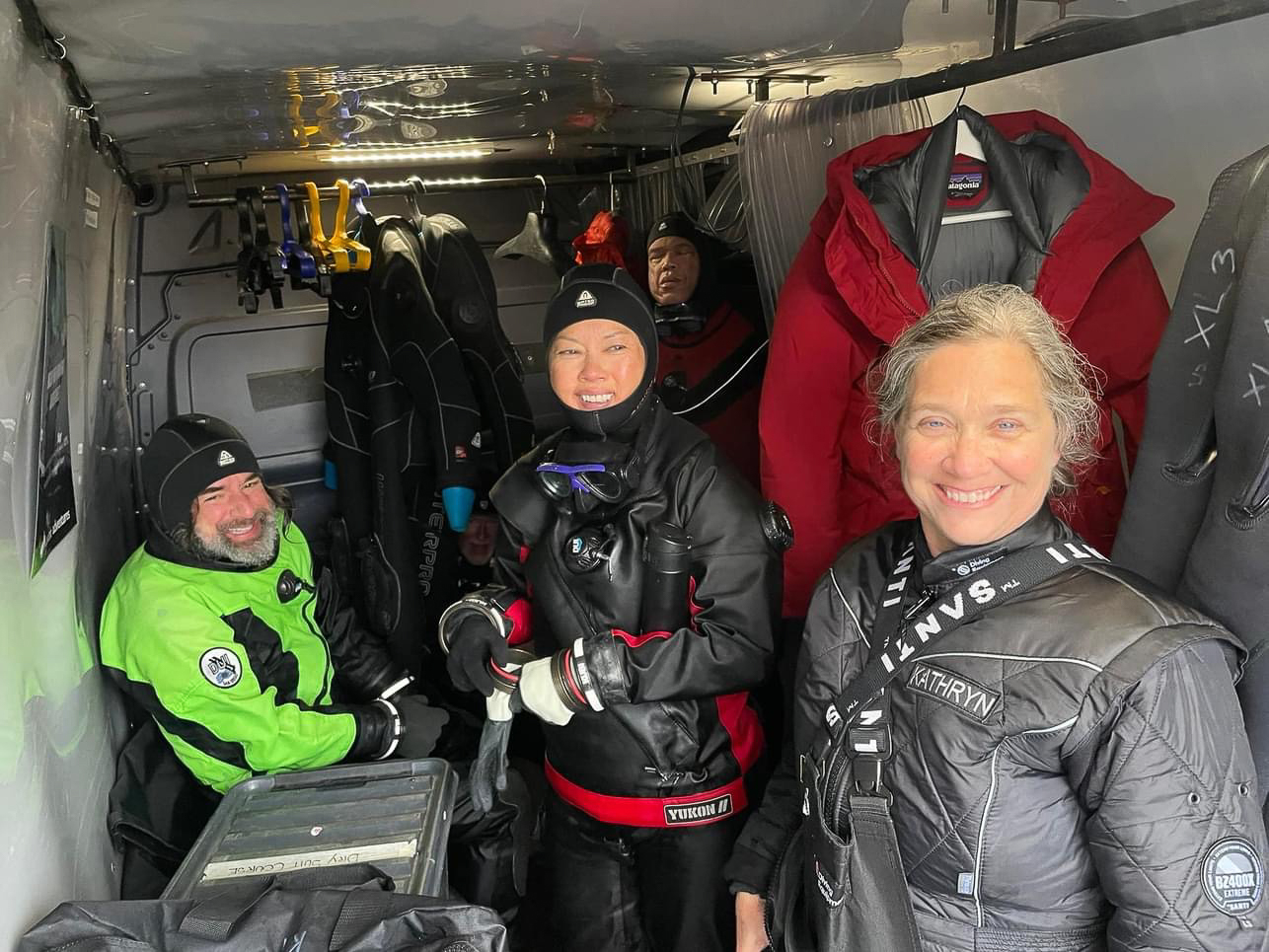
I’m kind of amazed seeing how broad these Silfra surface interval smiles are, huddled in the warming truck. Poor Janeiro, not smiling in the back, really suffered with the cold, enough to skip at least one second dive, but Greg, I and Kathryn appear to be enjoying ourselves. Maybe we just finished a round of harðfiskur?
Although the forecast was for sun in the afternoon, it was still cloudy when we entered the water for our first dive. The sun did burst forth midway through that dive and glowed brightly for the second. This seemed appropriate, for this was the eve of the first official day of summer in Iceland.
It all came together for our us on our final Silfra circuit: sun and almost warm hands. We lasted a record 53 minutes, with depth maximum of 29 feet. We later learned Mehmet missed the turnoff to the lagoon and ended up in the lake, which could have been catastrophic (it’s huge!). It seems dive guide Guillaume made the turn thinking Mehmet was behind him. Presumably Mehmet was looking in another direction just when Guillaume made the critical turn and was swept into the lake by the current. Somehow he made his way to the lake shore and had an even longer than usual, cross-country walk in front of him, fully geared up and further loaded down with his camera .
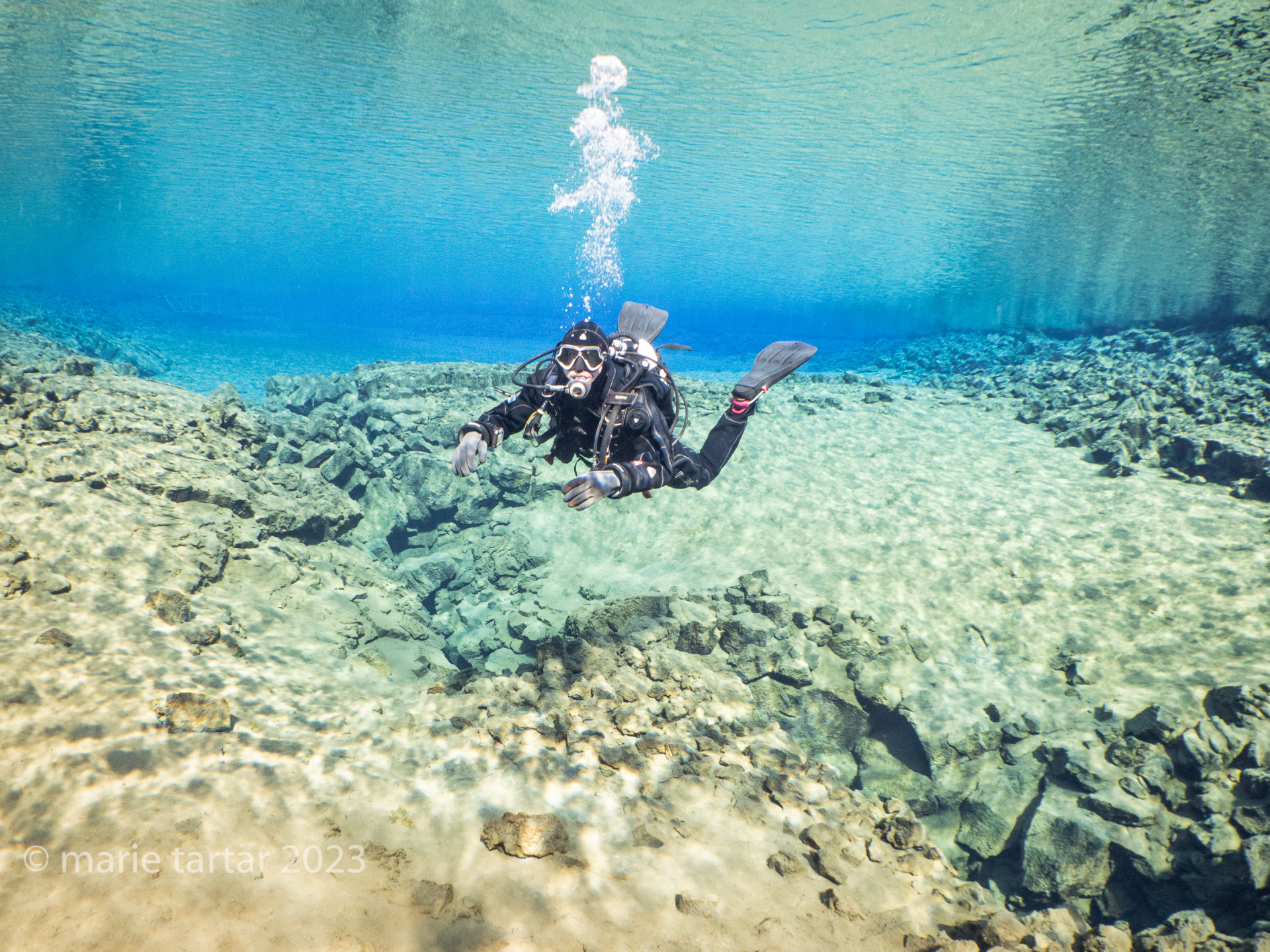
Silfra, Day 3: A welcome sight: Mattia in the lagoon, marking the end of the dive at Silfra. The stairs leading out can be faintly seen through the blue water on the left.
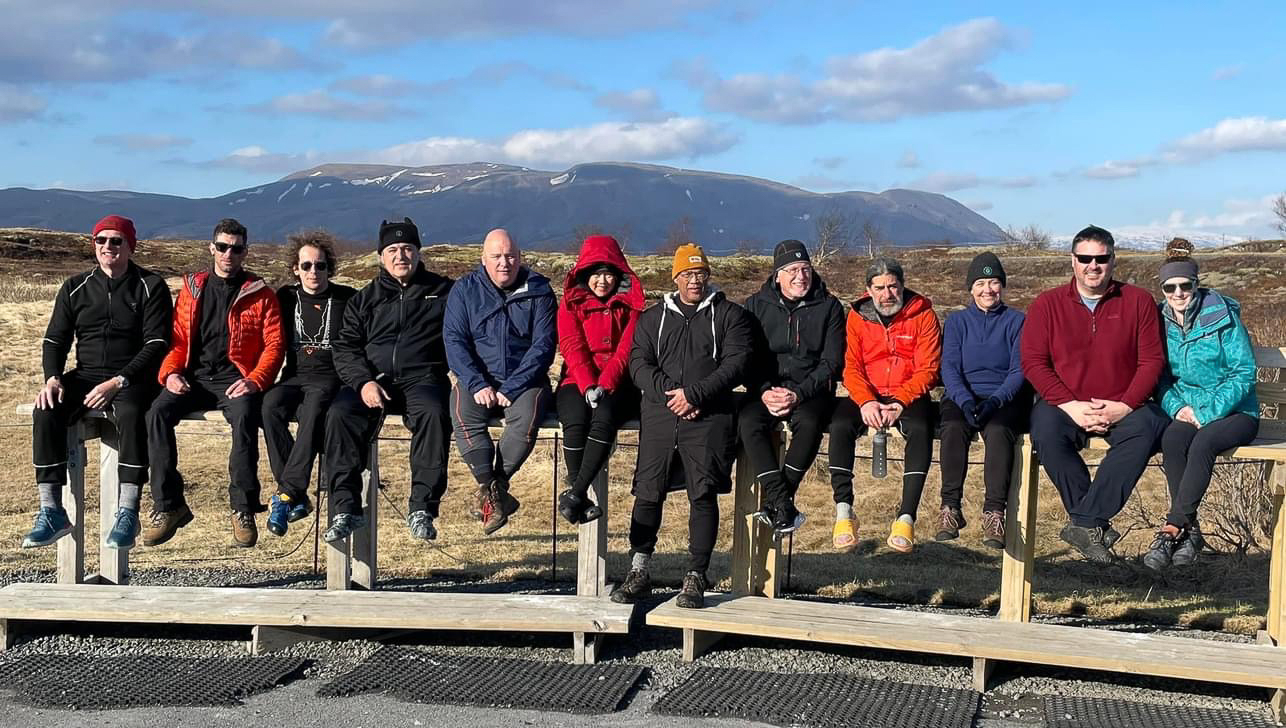
The we-survived-Silfra Alex Mustard workshop group photo, taken after our 3rd and final and only sunny diving day. From left: Philip, Guillaume, Mattia, Mehmet, Alex, me (looking like a 6 year old deep in my wonderfully warm down Patagonia coat), Janeiro, Steve, Greg, Kathryn, Brian and Jillian. Not pictured: Byron, who coordinated our trip and presumably manned the camera for this portrait and Eliska, dive guide and bus driver and (for me personally) finger savior.
Steve and I did a quick turn-around back in Reykjavik, as we were invited to dinner with Harpa and her family. We exchanged our house in Sedona with Harpa on our prior visits and finally met the family in person in San Diego when they did an exchange nearby. Over a lovely meal of grilled lamb, we caught up in their beautifully renovated and decorated house on a lovely tree-lined street within walking distance.
Friday, April 21, 2023
Our gear was left overnight at the Dive Center to dry, while the group loaded up in a van headed to the South coast, with Eliska at the wheel and Byron accompanying us for a land excursion.

Footwear suggestions for walking on a glacier in Iceland; even our Pajar winter boots from Canada with built in crampons did not make the cut! Evidently, crampons do not mate optimally with stilettos or flip-flops.
We arrived at Sólheimajökull glacier, a finger-like extension of the Mýrdalsjökull glacier, where Basha from Poland took charge kitting us out with hiking boots with good ankle support, crampons, ice axes, helmets and new to us, harnesses which looped over our waists and upper thighs, lest we fall into a crevasse and need to be rescued (as actually happened to Oliver, our guide on our prior week’s glacier walk).
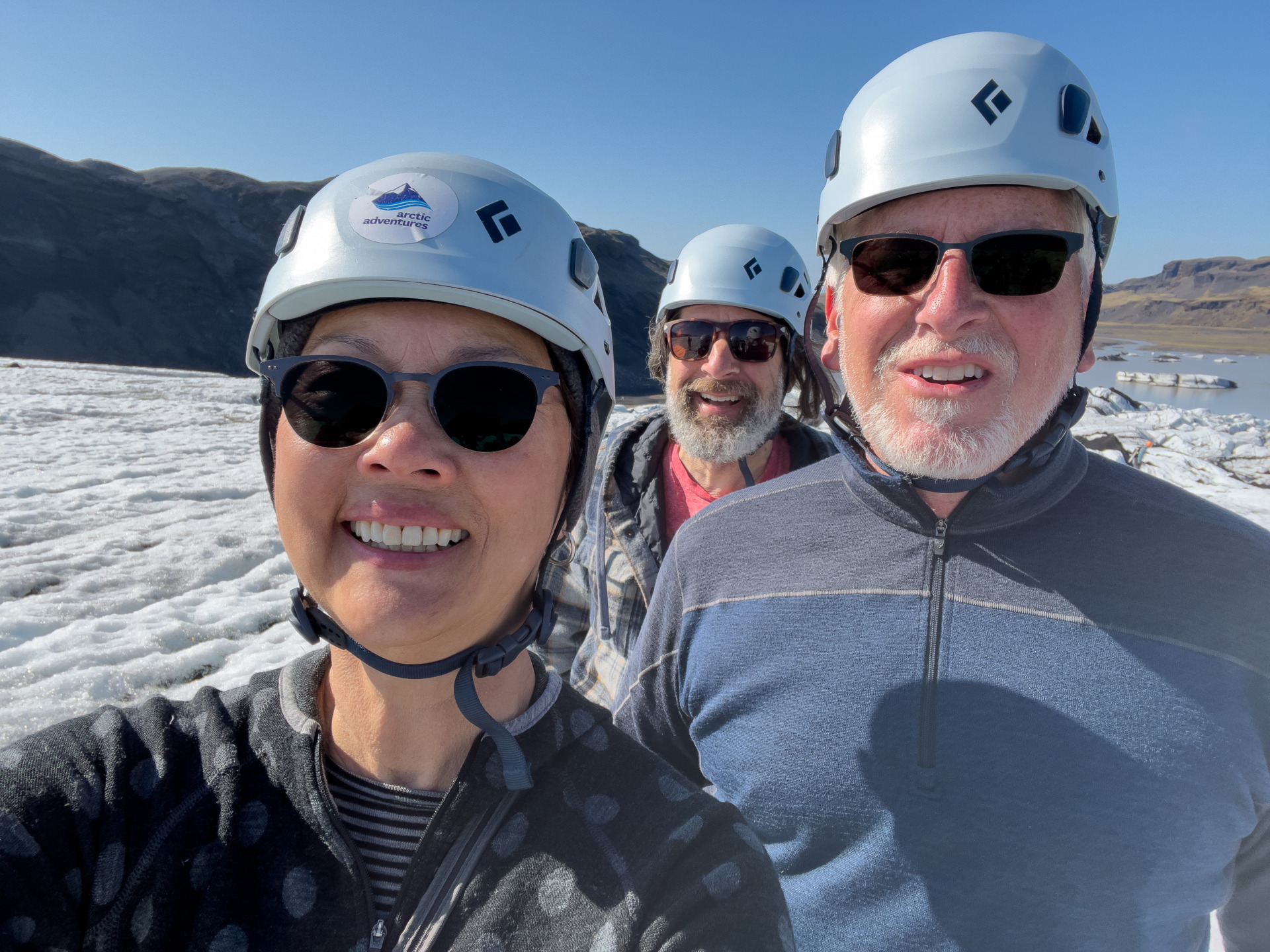
What the well-dressed glacier walkers are wearing this season:helmets! It was warm enough walking up the glacier to leave coats behind.
It was a beautiful sunny day for a glacier walk, stomping our way up onto the crunchy ice.

Greg demonstrates the Viking pushup over an ice-cold stream (or why we lugged those ice axes along on our glacier walk).
Lunch was at Vik’s black sand beach. The restrooms, restaurant and beach were thronged but the cod filet I ordered for lunch was tasty and substantial enough to tide me over until our 9 pm dinner reservation at Dill.
Back in Reykjavik at the dive center, we loaded up our gear into bags for transport back to the hotel for organization and packing. There was just enough time left for a shower, underwater camera break-down and most of the packing before it was time to walk to Dill for for our 9 pm dinner, just 3 blocks away now, having moved since we ate there last in 2015.
Dinner at Dill has been a highlight of each of our trips to Iceland, starting back at their Nordic Center location back in 2012 and in downtown Reykjavik in 2015. Their new location was on a second floor on the main drag, Laugavegur. It was attractive, with a moody and modern ambiance I call Nordic noir, all dark tones and spare lines. We had talked food quite a bit during our travels with Byron the prior week, so had asked him to join us as an additional thank to him for an outstanding 2 week trip.
The menu was cryptic, just a sketch of the miniature delights to follow, 18 small courses, some no bigger than a bite. From the trio of starters to the array of tiny desserts, it was a parade of culinary surprises, prominently featuring local ingredients. The first appetizer of lumpfish roe with chervil was a savory start, followed by a thimble of grilled vegetable soup with a horseradish note. Even more prosaic sounding offerings (onion cake, carrots) looked like it had taken a team of chefs to assemble, with thinly shaved carrots arranged into a scalloped layer on top of the button mushroom sized cake

One of the Dill’s delights, described only as (onion cake, carrots). Most courses were bite size and consumed so quickly there was nothing left to photograph!
One of my favorite dishes was a small salad of greens and fermented cabbage with Tindur cheese. There were two monkfish courses (cheeks with sea truffles and fillet with rutabaga and brown butter) and two pork dishes (cheeks with black garlic and belly with Nordic wasabi and whey). All these tasty treats were consumed avidly. The tariff wasn’t terrible, arguably a great value (19,500 Kronor, roughly $145 US), both considering the quality of the experience, the beauty of the presentation, and that food in general in Iceland is not inexpensive. The wine pairing, which Steve, Greg and I elected, doubled the cost. Wines are generally costly in Iceland, subject to import taxes. Our tasting included 5 wines, starting with a 2020 Lebanese wine from the Bekaa Valley (Musar Jeune from Chateau Musar) and ending with an Italian (Veneto) non-vintage Rosso Col Fondo from Zanotto. My favorites of the wines we sampled were a Christophe Mignon champagne (ADN de Meunier) and a 2021 Gruner Veltliner from Austria (Weingut Hajazan Neumann, located within Vienna city limits).
We all thoroughly enjoyed the meal, truly a wonderful sendoff and a fantastic note on which to end an unforgettable return to Iceland. The only wish which didn’t come true for us this trip was to see the Northern Lights again (we have only seen them in Norway in September). It could have happened-Brian and Jillian did luck out with aurora borealis on their self-driving trip to the Snaefellsnes Peninsula after Silfra.
Back in the US (first in New York for a few days and later in San Diego), what I dubbed the “Byron effect” was in full force. Interspersed with the usual New York pursuits of catching up with friends over a meal (dim sum with Wren and Henry at Jing Fong), a bird walk with Birding Bob in Central Park and theatre (Jodie Comer was unforgettable and searing in the sexual misconduct themed one woman drama, Prima Facie, for which she won best actress Oliver and Tony awards), we watched a gripping commercial diving drama Byron recommended, The Last Breath. Although we couldn’t fit one into our miniscule New York kitchen, Byron’s endorsement of the misnamed air fryer led us to acquire first one, then a second, for San Diego and Sedona. A month later in Sedona, through the familiar scenery near Vik, we relived our trip to southern Iceland, one episode each night, via an Icelandic sci-fi drama named for the volcano, Katla, another of Byron’s recommendations.
Iceland was also on my mind in my reading. I devoted 20 hours of multi-tasking (mostly driving to and from work, running errands or cleaning up Steve’s dinner preparations) to listening to Halldor Laxness’ 1934 novel Independent People. The protagonist is an unforgettable character, a stubbornly cantankerous sheep farmer known as Bjartur of Summerhouses. He is determined not to be beholden to anyone, even if the well-being of his family or flock is at stake. I can see why is it considered a classic. Laxness, who won the Nobel Prize in 1955, recalls traditional Icelandic sagas and epic poetry in depicting the harshness of the landscape and Bjartur’s constant struggles to make a success of his farm in the years before WW I. Bjartur is a flawed person, hard-nosed and irascible, difficult to like, but in a completely different way from the hapless protagonist of a contemporary Icelandic novel I read at the same time, 101 Reykjavík. Hlynur Björn is a 30-ish year old slacker living with his mother and the creation of author Hallgrimur Helgason. Thankfully, the only Icelanders we know are not anything like these two diametrically opposed extremes!
Traveling with a non-Icelandic guide, Byron, provided interesting contrasts with our prior trip with Chris. Byron brought an insightful “outsiders” perspective to the country, despite having lived there for 8 years and becoming a citizen (being from the UK, this was relatively easy before Brexit). He shared a variety of observations, noting that almost all adventure guides are not Icelandic, while Icelanders who work in tourism-related prefer support staff jobs, like bus drivers. We were surprised to hear that many Icelanders are heavily in debt but quite relaxed about it. When we tried to get guidance from him as to how much to tip guides, he emphasized that guides are well paid. Indeed, it seems the general standard of living in Iceland is high, with free education through university, universal health care and no mosquitos! We weren’t diving in summer, so didn’t have a chance to try out Byron’s remedy for midges. He claimed balancing a fin on your head would banish midges! But maybe, just maybe, he was pulling our legs?
-Marie

